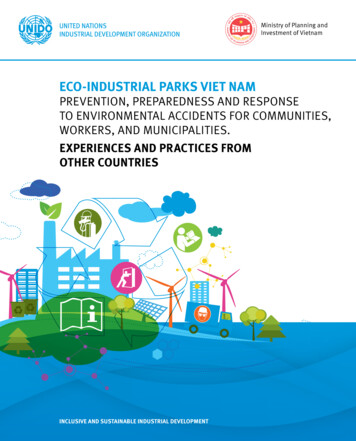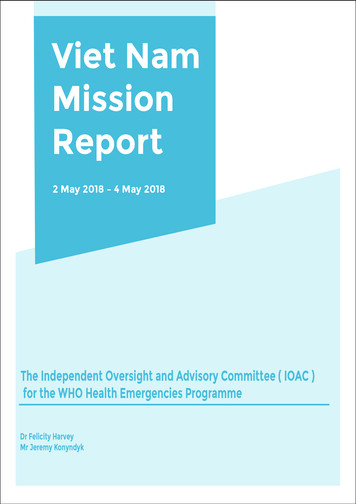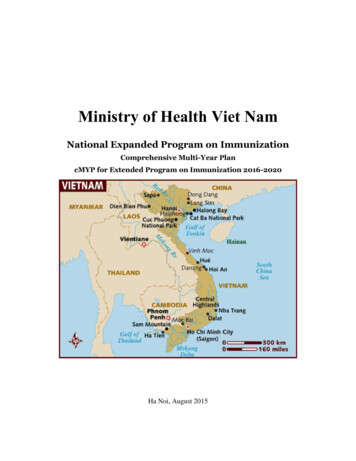
Transcription
Ministry of Planning andInvestment of VietnamECO-INDUSTRIAL PARKS VIET NAMPrevention, preparedness and responseto environmental accidents for communities,workers, and municipalities.Experiences and practices fromother countriesINCLUSIVE AND SUSTAINABLE INDUSTRIAL DEVELOPMENTI
DISCLAIMERThis document has been produced without formal United Nations editing. The designations employed and the presentation of the material in this document do not imply the expression of any opinion whatsoever on the part of the Secretariatof the United Nations Industrial Development Organization (UNIDO) concerning the legal status of any country, territory,city or area or of its authorities, or concerning the delimitation of its frontiers or boundaries, or its economic system ordegree of development. Designations such as “developed”, “industrialized” and “developing” are intended for statistical convenience and do not necessarily express a judgment about the stage reached by a particular country or area inthe development process. Mention of firm names or commercial products does not constitute an endorsement by UNIDO.Although great care has been taken to maintain the accuracy of information herein, neither UNIDO nor its Member Statesassume any responsibility for consequences which may arise from the use of the material.This document may be freely quoted or reprinted, but acknowledgement is required.Vienna, 2019.Pictures: 123rf.comII
Prevention, preparedness and response to environmentalaccidents for communities, workers, and municipalities.ContentsAcknowledgments IVAcronyms and AbbreviationsVIntroduction 1I. Classification of natural disasters and environmental accidents1.1. Natural disasters1.2. Environmental accidents234II. Disaster management2.1. Prevention and preparedness2.1.1. Roles and responsibilities of the various interested stakeholders2.1.2. Mock disaster drills91111192.2. Emergency Response2.2.1. Emergency Response Procedure2.2.2. Roles and responsibilities of the various interested stakeholders2424272.3. Protocols for notifications to the authorities: bodies and compensation35References 40Annex: Questions for your evacuation plan43List of figuresFigure 1. Disaster classificationFigure 2. Disaster management processFigure 3. Emergency Management CycleFigure 4. Appell process291025List of boxesBox 1: Example of a typhoon that caused an industrial disasterBox 2: Example of environmental accident classification according toRed Cross and Red Crescent National Societies (IFRC)Box 3: Example of environmental incident classificationaccording to Transport Road & Maritime ServicesBox 4: Example of preparedness and response procedures developedby Environment Protection Department of Hong KongBox 5: Example of national drillsBox 6: Example of community and staff drillsBox 7: Summary - Differences in emergency proceduresfor natural disasters and environmental accidentsBox 8: Example of lengthy litigation8881820233539III
Acronyms and AbbreviationsAPELL Awareness and Preparedness for Emergencies at Local LevelARA Appropriate regulatory authorityCOA certificates of authorizationCPR cardiopulmonary resuscitationDDM Department of Disaster ManagementEMR Environmental Management RepresentativeEMS Environmental Management SystemEPA Environmental Protection AgencyEPD Environmental Protection Department (of Hong Kong)ERP Environmental emergency response procedureGDP gross domestic productIZ industrial zoneIFRC Red Cross and Red Crescent National SocietiesNTRS NT Recycling SolutionsOECD Organisation for Economic Co-operation and DevelopmentPMU Project Management UnitUNEP United Nations Environment ProgrammeUNIDO United Nations Industrial Development OrganizationWB World BankWHO World Health OrganizationIV
Prevention, preparedness and response to environmentalaccidents for communities, workers, and municipalities.ACKNOWLEDGEMENTSThis report was prepared by the Center for Environment and Community Development (CECoD) within theframework of the UNIDO project “Implementation of Eco-industrial park initiative for sustainable industrial zonesin Vietnam”, co-implemented by UNIDO and the Ministry of Planning and Investment of Viet Nam.We would like to thank To Kim Lien for drafting the report, Nguyen Trinh Huong, assignment team leader, andthe Project Management Unit of the project “Implementation of Eco-Industrial Park Initiative for SustainableIndustrial Zones in Vietnam” for their valuable comments to the report. In particular, we would like to send deepthanks to Alessandro Flammini, UNIDO Vienna, for his detailed guidance, review and contribution to the text.Additionally, we would like to thank Melanie Pisano for editing the report.For more information please visit https://eipvn.org/ or contact EIP@unido.orgCENTRE FOR ENVIRONMENT ANDCOMMUNITY DEVELOPMENTV
REPORT ONPrevention, preparedness and responseINTRODUCTIONEnvironmental accidents and natural disasters are increasing in number and intensity.Most of them are unpredictable, and so people have to be well prepared to protectthemselves in the most secure ways. The impacts from disasters are extremely devastatingand significantly affect people, the environment and business organizations. Moreover,the risk of industrial accidents should not be underestimated. Indeed, a firm can be theobject of an accident that could have been avoided with the proper controls and safetymeasures. A lot of prevention is required in order to avoid and/or minimize the risk ofindustrial accident that could happen.This report is part of Component 1 (Review and analyze international and domesticexperience on environmental accidents) of the assignment, “Capacity building incommunities to respond to environmental accidents or disasters from industrial zones”.The overall objective of this report is to provide a comprehensive review of internationaland national experiences on prevention, preparedness and response to environmentalaccidents to ensure that all stakeholders are able to respond in a timely and effectivemanner.This report was prepared for Vietnam’s reference and use. It includes guidance forpreparedness and steps to follow from emergency scenarios from other countries in theregion, such as Japan, the Philippines and Indonesia. Additional experiences and lessonslearned from other international organizations, such as World Health Organization (WHO),United Nations Environment Programme (UNEP) and Red Cross and Red Crescent NationalSocieties (IFRC), etc., have been reviewed and considered while compiling this report.1
I. C lassification of naturaldisasters and environmentalaccidentsClimate change impacts have increased the awareness of the threat that natural disasters pose on communitiesalready prone to extreme weather events, and to industrial zones, chemical facilities and critical infrastructuresuch as oil, chemical and gas tanks/storage, pipelines and nuclear plants. These environmental accidents, oftencaused by natural disasters, can have severe consequences for the agriculture, ecosystems, human health,economy development and industries. According to the World Bank, Vietnam loses 1-1.5 percent of GDP annuallydue to natural disasters, which hinders the social and economic development of the country (World Bank, 2009).Disasters are divided into two groups: natural and environmental. Some authors consider environmental disastersan accident caused by people or technology. Figure 1 describes disasterclassification, natural and ‘man-made’, and components of each type (Faleschini, F. et al., 2017).Figure 1. Disaster classificationDisastersEnterprise agrees- Earthquakes;- Landslides;- Floods;- Storms;- Typhoons; and- Tornadoes2‘Man-made’ andtechnological- Hazardous materials;- Radiologicalemergencies;- Chemical threats andbiological weapons;- Technological disasters(e.g. explosions, nuclearand industrial accidents,and structural collapses);- Etc.
Prevention, preparedness and response to environmentalaccidents for communities, workers, and municipalities.Natural disastersA natural disaster is a major event resulting from natural processes of the earth, for instancefloods, hurricanes, earthquakes etc. In recent times, there has been an increased awarenessof the threat that natural disasters pose to industrial zones.Environmental accidentsEnvironmental accidents are major events resulting from human activity, such as oilspills, toxic rain, chemical leaks, pollution, fires and explosions and often result in severeconsequences for the environment and human health.1.1. Natural disastersEarthquakesEarthquakes are one of the most deadly natural disasters; generating the largest number of human casualties, andare estimated to be responsible for 35 percent of the economic loss generated by natural disasters. Earthquakes cancause environmental, infrastructural and industrial disruptions and accidents. Industrial accidents often happenwhen the earthquakes are a 7.0 magnitude or higher.Challenges:-Industrial facilities located in seismic areas with inadequate building structures;-High population density in industrial areas; and,-Inadequate warning systems.Possible physical damages:-Ground shaking, soil liquefaction and landslides;- Collapse of industrial buildings;- Destroyed industrial equipment;- Earthquakes can result in the release of hazardous materials, such as chemicals. This can lead to burnsfrom exposure to the chemicals and respiratory injury from the inhalation of dangerous gases, heavy dustproduced by damaged tanks and equipment;- Explosions and fires;- Electrocution from power lines that has fallen down;3
-Injuries and deaths caused by collapsed buildings and landslides;- Destroyed infrastructure and disrupted power supply, water supply, transport and communication; and,- Evacuation sites have an increased risk of infectious diseases, inability to provide adequate treatmentsand sanitation, etc.FloodsFloods are one of the most frequent natural disasters to trigger industrial accidents. The frequency of majorflooding events is increasing because of climate change and urbanization. There are several kinds of floods.Floods can be predicted in advance. Conversely, flash floods are sudden, extreme, and therefore difficult toforesee, which gives people less time to react.Challenges:-Industrial facilities in flood-prone areas with inadequate building structures;-Inadequate warning systems and safety measures;-High population density around industrial areas;- Lack of public awareness ;Possible physical damages:- Damage to pipework, storage tanks and industrial equipment;- Release of hazardous materials, such as chemicals;- Disruption of the infrastructure, water supply, power supply and communication;- The damage to the industrial storage tanks and equipment can lead to the release of hazardousmaterials, such as dangerous chemicals that can severely contaminate the water and the environment;- Floods can distribute toxic or flammable materials over wide areas and thereby increasing the risk to thesurroundings;-Pollution, such as water pollution or toxic cloud pollution;-Burns from fires or dangerous chemicals, respiratory injury from the inhalation of toxic chemicals orgases;- Fire, explosions and collapsing buildings; and,- Evacuation sites have an increased risk of infectious diseases, inability to provide adequate treatmentsand sanitation, etc.4
Prevention, preparedness and response to environmentalaccidents for communities, workers, and municipalities.Tropical stormsHurricanes, typhoons and cyclones are intense tropical storms with winds of at least 120 km/h. These stormscan be predicted in advance, but these disasters are often very extensive and destructive. Tropical storms arepredicted to increase in frequency and intensity, because of climate change impacts. They can be hundreds ofkilometers wide and are often accompanied by flooding, lightning and sometimes tornadoes.Challenges:-Inadequate building structures;- Structures that are vulnerable to storm damage and lightning strikes;-Inadequate warning systems and safety measures;-High population density around industrial areas; and,- Lack of public awareness about the risks of natural disasters, such as tropical storms.Possible physical damages:- Damage to buildings, power lines, pipes, etc.;- Lightening during thunderstorms can affect electrical control systems and damage vulnerable equipmentor storage tanks;- Release of dangerous materials, such as chemicals or gases. Ruptured storage tanks can release gaseoustoxic chemicals and blow over populated areas or can dissolve in rainwater and create corrosive rain;-Pollution, water pollution, toxic clouds, corrosive rain, etc.;- Lightning can directly strike structures and storage tanks that contain flammable materials, causing firesor explosions. Oil and gas facilities are particularly vulnerable; and,- Disruption of infrastructure, power supply and communication.Box 1: Example of a typhoon that caused an industrial disasterTyphoon Haiyan hit the Philippines on 8 November 2013 with a wind of 315 km/h. It caused significantdamage to cities, villages and infrastructure. It broke loose a power barge anchored south of Estancia thathit the shoreline and ruptured. Over 800,000 litres of fuel released into the 10 km coastline. People startedto clean up the oil manually, but without adequate protective equipment, they were exposed to the oil. Theimpact on aquaculture and coastal vegetation ultimately affected the local communities who depended onfishing (AGHAM, 2014).5
1.2. Environmental accidentsEnvironmental incidents are often caused by failure or mishaps that include fuel, oil, chemicals and otherdangerous material spills, contamination of water, land or air, fires, explosions or accidents, and illegal dumpingwaste, etc. This can occur during the production, transportation or handling of hazardous chemical substances.This can also happen during natural disasters and can cause fires, burns, explosions, and pollution, etc.Often authors classify environmental incidents according to the nature of incidents as described below. However,there are authors/organizations that classify environmental incidents according to the seriousness of theincidents.Nuclear explosion/RadiationAccidental nuclear explosions or radiation can result from natural disasters disrupting a nuclear plant, which cancause an explosion of the plant and the release of radioactive materials. This often has severe consequences forthe people and environment exposed to the blast or radiation.Possible physical damages:-Pollution and destruction of wildlife and vegetation;-Physical damage of the blast. It can injure humans by rupturing eardrums or lungs, and causes moderatedamage to buildings, etc.- The radiation can damage the cells of the body and cause sickness and death;- Fire can cause death, burn and injuries; and,- Damage electrical power equipment.Acid rainAcid rain is rain, snow, fog, hail or dust that has an excessive concentration of acid as a result from chemicalpollution. Acid rain is caused by the burning of fossil fuels to generate electricity, vehicles and heavy equipmentand manufacturing, oil refineries and other industries. The wind can blow the acid rain over long distances andacross borders, which makes acid rain a global problem and not just for the people living in industrial zones.Possible physical damages:- The acid is absorbed by the soil and water, which causes agricultural and ecological damage to thevegetation and wildlife;6-It can cause a corrosion of steel structures, such as bridges; and,-It affects human health and can create heart and lung problems.
Prevention, preparedness and response to environmentalaccidents for communities, workers, and municipalities.Chemical pollutionChemical pollution is the release of chemicals into nature and it disrupts the ecosystem, threatening the health ofhumans, wildlife and vegetation. It can pollute the air, water, food, soil etc. and lead to internal body disorders.Possible physical damages:- Damage to the health of humans and wildlife. It can impair immune systems, trigger asthma, affect thedevelopment of organs, etc.- Disruption of the ecosystem threatening wildlife and vegetation.Atmosphere pollutionAtmospheric pollution is the release of dangerous chemicals or materials into the atmosphere, which can havesevere consequences. The release of gases, solids, chemicals or radiation into the atmosphere through burningnatural or artificial fuels or chemicals in the industrial processes and by nuclear explosions causes atmospherepollution.Possible physical damages:- The release of carbon dioxide is a major cause of climate change;- The release of chemicals or gases can form dangerous acid rain, toxic clouds or smog; and,- Atmospheric pollution is harmful to humans and is a major cause for cancer.7
Box 2: E xample of environmental accident classification according to Red Crossand Red Crescent National Societies (IFRC) (IFRC, 2011):üAccident release: Occurring during the production, transportation or handling of hazardous chemicalsubstancesüExplosions: Disasters will only be classified as explosions when the explosions is the actual disaster.If the explosion is the cause of another disaster, the event will be classified as the resulting disaster.üChemical explosion: Violent destruction caused by explosion of combustible material, nearly always ofchemical origin.üNuclear explosion/Radiation: Accidental release of radiation occurring in civil facilities, exceeding theinternationally established safety levels.üMine explosion: Accidents that occur when natural gas or coal dust reacts with the air.üPollution: Degradation of one or more aspects in the environment by noxious industrial, chemicalor biological wastes, from debris or ‘man-made’ products and from mismanagement of natural andenvironmental resources.üAcid rain: A washout of an excessive concentration of acidic compounds in the atmosphere, resultingfrom chemical pollutants such as sulphur and nitrogen compounds. When deposited these increasethe acidity of the soil and water causing agricultural and ecological damage.üChemical pollution: A sudden pollution of water or air near industrial areas, leading to internal bodydisorders with permanent damage of the skin.üAtmosphere pollution: Contamination of the atmosphere by large quantities of gases, solids andradiation produced by the burning of natural and artificial fuels, chemicals and other industrialprocesses and nuclear explosions.Box 3: E xample of environmental incident classification according to Transport Road & MaritimeServices (New South Wales, Australia) (Transport Road & Maritime Services, 2017). There arethree categories of environmental incidents/events that are to be identified and managed: Category 1 Incidents - potentially the most serious incidents. They generally reflect breaches ofenvironmental legislation. Category 2 Incidents - are generally less environmentally serious and generally have lower maximumpenalties. Nevertheless, there are sound policy reasons why these incidents need to be identified andreported in order to track potential trends that may lead to Category 1 incidents if not addressed. Reportable Events - This category captures events that occur outside the scope of reasonable controlsand mitigation.8
Prevention, preparedness and response to environmentalaccidents for communities, workers, and municipalities.II. Disaster managementIFRC defines Disaster Management as the organization and management of resources and responsibilities fordealing with all humanitarian aspects of emergencies, in particular preparedness, response and recovery in orderto lessen the impact of disasters (see Figure 2) (Figure source: IFRC, 2011):Figure 2. Disaster management processReducingrisk of disastersRecovering from disastersDisasterDisastermanagementPreparingfor disastersRespondingto disastersReducing risk of disastersAccording to WHO, disaster management can be implemented through the following steps (WHO, 2002):-Vulnerability assessment: This provides the basis for reducing vulnerability through work in two areas:disaster prevention/mitigation (to reduce susceptibility) and emergency preparedness (to increaseresilience). Vulnerability assessment makes it possible to anticipate problems that specific groups willface in the event of a disaster and during the period of recovery. The process of vulnerability assessmentinvolves determining the spatial proximity of population subgroups to potential hazards (an assessmentof susceptibility), according to personal and socioeconomic characteristics that may influence theimmediate and long-term impact of hazards on them (an assessment of resilience).-Prevention and mitigation: Complete prevention of disasters is feasible only if it is possible to eliminatepeople’s susceptibility to hazards by moving populations away from hazard zones, providing completeprotection from hazards, or preventing the physical hazard altogether. Mitigation—actions aimed atreducing (but not eliminating) the impact of future hazard events—and reduction of the susceptibility ofhigh-risk groups are then the goals.-Emergency preparedness: Emergency preparedness is “a programme of long-term development activitieswhose goals are to strengthen the overall capacity and capability of a country to manage efficiently alltypes of emergency and bring about a transition from relief through recovery, and back to sustaineddevelopment.”9
-Planning, policy and capacity building: Planning is required at all levels, from the community levelto national and international levels. Planning ensures that programmes for disaster prevention andmitigation are deployed with clear objectives, adequate resources and management arrangements,and that strategies, resources, management structures, roles and resources for emergency responseand recovery are determined and understood by key actors. The complete disaster-management cycleincludes the shaping of public policies and plans that either modify the causes of disasters or mitigatetheir effects on people, property, assets and infrastructure. Institutional capacity should also beincreased through organizational innovation and training.-Emergency response: The appropriate response will depend on the nature of the emergency or disasterand the effectiveness of mitigation measures, but is also very much conditioned by the degree ofpreparedness achieved. The aim of emergency response is to provide immediate assistance to maintainlife, improve health and support the morale of the affected population.-Rehabilitation, reconstruction and recovery: As the emergency becomes under control, the affectedpopulation is capable of undertaking a growing number of activities aimed at restoring their lives andthe infrastructure that supports them. This may be a slow process and one in which the capacity for suchefforts must be carefully nurtured and built up over a period of time, but the process should start early inthe emergency phase.The Organization for Economic Co-operation and Development (OECD) has developed a technical guideline forindustry (including management and labor), public authorities, communities and other stakeholders on principlesfor Chemical accident Prevention, Preparedness and Response. The guidelines address these stages, and the rolesand responsibilities of the different stakeholders in each stage within an entire process described as a “SafetyContinuum” of “Emergency Management Cycle” (OECD, 2003).Figure 3. Emergency Management CycleSafety ContinuumPrevent – avoiding incidentsand lessening impacts, andlearning from experienceto reduce vulnerability andincrease resiliencePreparedness – being alert, ready andtrained to act prior to the onset of anaccidentResponse – managing the consequences of anaccident and providing immediate relief, as wellas taking steps towards restoring and returningto normalityReference documents show that disaster/emergency management cycle can be broken down into separatecontents, or can include one or two contents per group. However, the three major pillars of the cycle remain asPrevention, Preparedness and Emergency Response. The following is a summary of experiences from differentsources.10
Prevention, preparedness and response to environmentalaccidents for communities, workers, and municipalities.2.1. Prevention and preparednessPrevention and preparedness are important in order to promote the populations health, a healthy environmentand the productiveness of the industrial zones. Several things can be done to establish prevention measures forenvironmental accidents. These prevention measures seek to promote the strengthening of programs to preventand response to environmental accidents.Prevention is the outright avoidance of adverse impacts of hazards and related disasters and Preparedness is thelessening or limitation of the adverse impacts of hazards and related disasters. Mitigation measures encompassengineering techniques and hazard-resistant construction, as well as improved environmental policies andpublic awareness (UNEP, 2015).2.1.1. Roles and responsibilities of the various interested stakeholdersThis part addresses the roles and responsibilities of the various interested stakeholders as local authorities,community, industry and others, recognizing that prevention is the concern of a wide range of different parties,synthesized from different sources.2.1.1.1. Local authorities and community representativesThe responsibility of the local authorities and community representatives (mass organizations, residential arealeaders, etc.) is to build disaster resilient communities and introduce strategies that can reduce the impact of adisaster. This should include:Partner up:-Identify local emergency response organizations and leaders and ask them to be part of your educationand planning efforts;- Recruit members of your community to participate in your emergency preparedness team;- Define roles and responsibilities of partners in an emergency;- Arrange meetings of community members through the development of a Community DisasterPreparedness committee; and,- Cooperate with the local fire department, police department, paramedics, or emergency managementagency to discuss ways to prepare your community and improve its capacity to respond and recover fromdisaster.Planning:- Develop comprehensive planning processes between public and private sectors to address the needs ofcommunities to maintain independence, medical care supervision, transportation, and communication;- Develop a regional all-hazards plan to address the needs of pets and livestock for evacuation, sheltering,and medical care during a catastrophic event;11
- Obtain information on potentially affected hazardous sites in order to assess the risks to health anddetermine the appropriate risk-management measures. This includes the development of risk profiles todetermine which potential emergencies to prioritize for planning;-Provide training to the majority of the community. Individuals are not prepared for an emergency.Experience tells us that citizens need to prepare to be self-sufficient during the initial 72 hours of acatastrophic incident;- Develop information, education and materials for specific target groups and vulnerable parts of thepopulation;- Know the natural or ‘man-made’ hazards that could affect a community, and seek advice on how to bestprepare for or mitigate these hazards.- Develop a neighborhood evacuation plan. Contact the local emergency management office and findout ahead of time what evacuation routes are designated for your area. Distribute maps to communitymembers and become familiar with major and alternative routes to leave your area before a disaster;- Evaluate special needs response for vulnerable individuals or parts of the population;-Identify members of the community who have special skills (medical, technical) or equipment that theywould be willing to share in the event of an emergency; and,- Coordinate emergency plans with the local schools. Make sure children know where to meet parents inthe event that schools are evacuated or an early release occurs.Early warning systems:-Build surveillance and forecasting systems so that events can be detected early and their effectsmitigated;-Provide standardization of early warning systems for municipalities and institutions across the region;and,- Educate the public about the early warning systems.Communication:- Ensure that responding organizations within the region have completely interpretable communicationcapabilities;-Inform the community about evacuation routes, temporary shelters, and other emergency procedures;and,- Create a list of home and work phone numbers and e-mail addresses for all community members, notingcontact information and plans for children and seniors who may be home alone during emergencysituations.12
Prevention, preparedness and response to environmentalaccidents for communities, workers, and municipalities.Preparedness:-Provide for adequate shelter, feeding, volunteer and logistical resources to address all-hazardscatastrophic event needs sufficient to sustain the region’s recovery for up to 72 hours without outsideresources;- Assure coordination of medical response capabilities and provide for uniformity of public healthemergency plans across the region;- Community members should have working fire extinguishers and know how to shut off their utilities, suchas gas, electricity, and water in the event of an emergency; and,- Encourage community members to develop family preparedness plans that cover emergency contactinformation for family members, predetermined meeting places, home evacuation procedures, emergencypet care, safe storage of food and water, and assembling disaster supplies kits.13
Education:Prevention should be a knowledge that people learn at school, home, and at wo
7) the eMr together with function/departmental Managers shall review the suitability, adequacy and effectiveness of the emergency plan after each accident or emergency and revise the emergency plan as necessary. 8) the eMr shall maintain documentation on emergency response and preparedness, and emergency incidents for at least three years.










